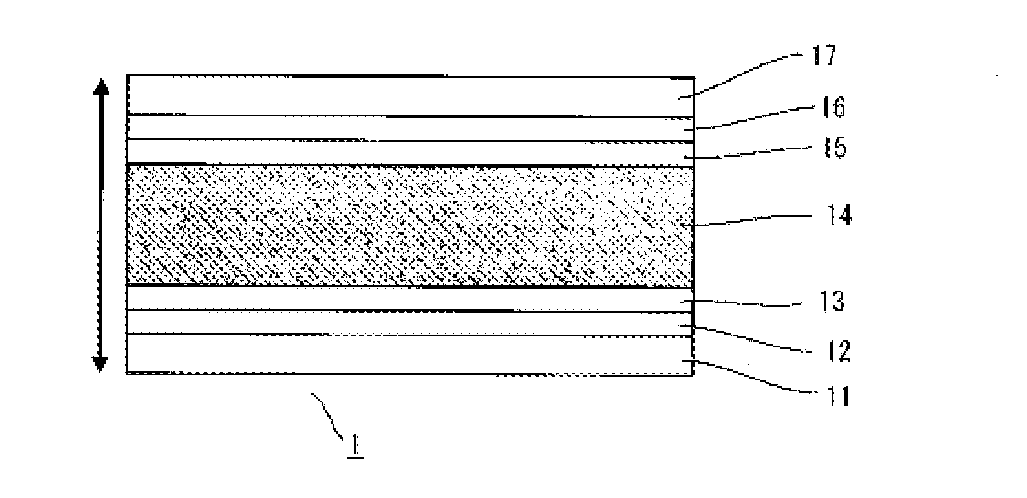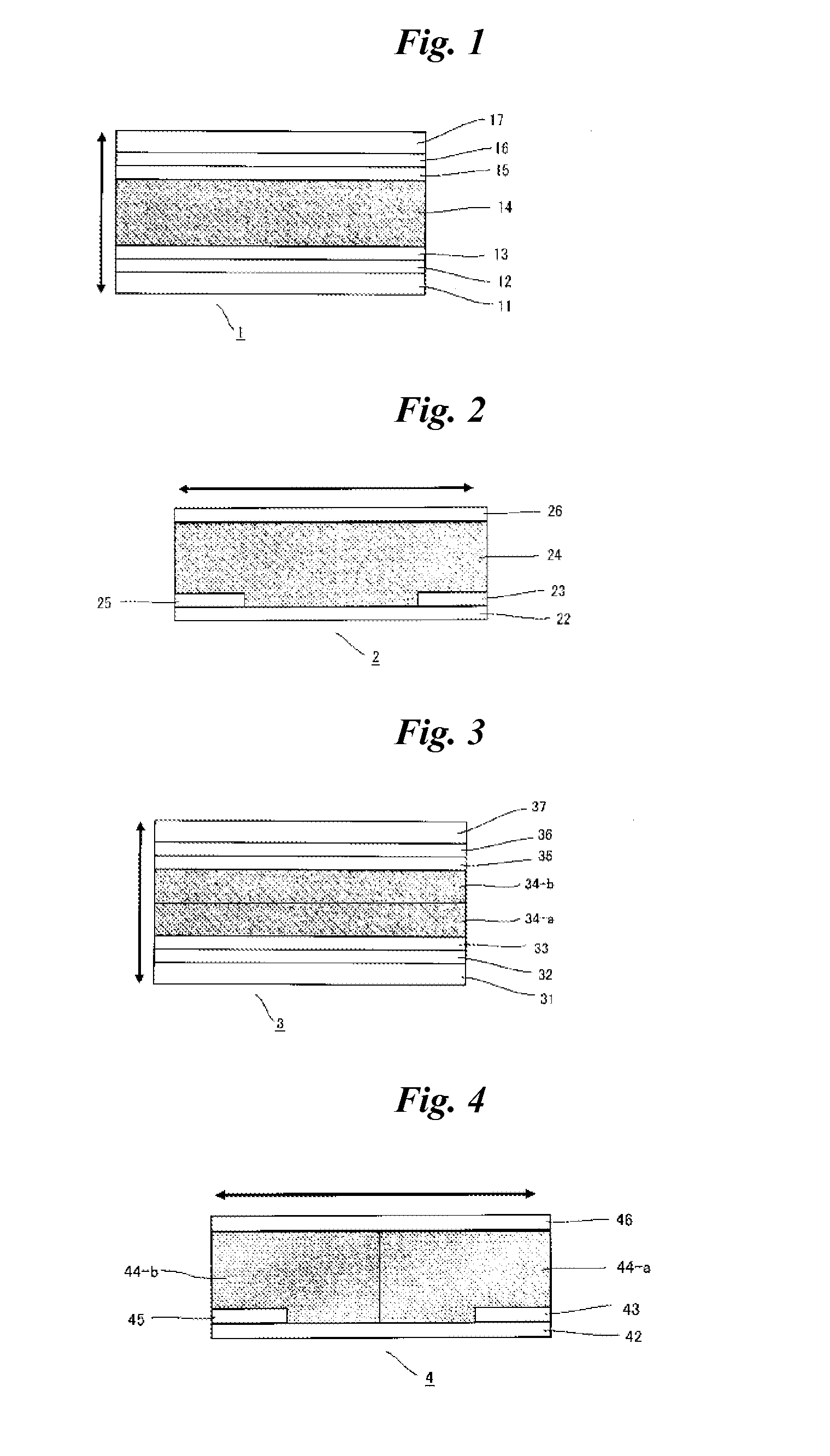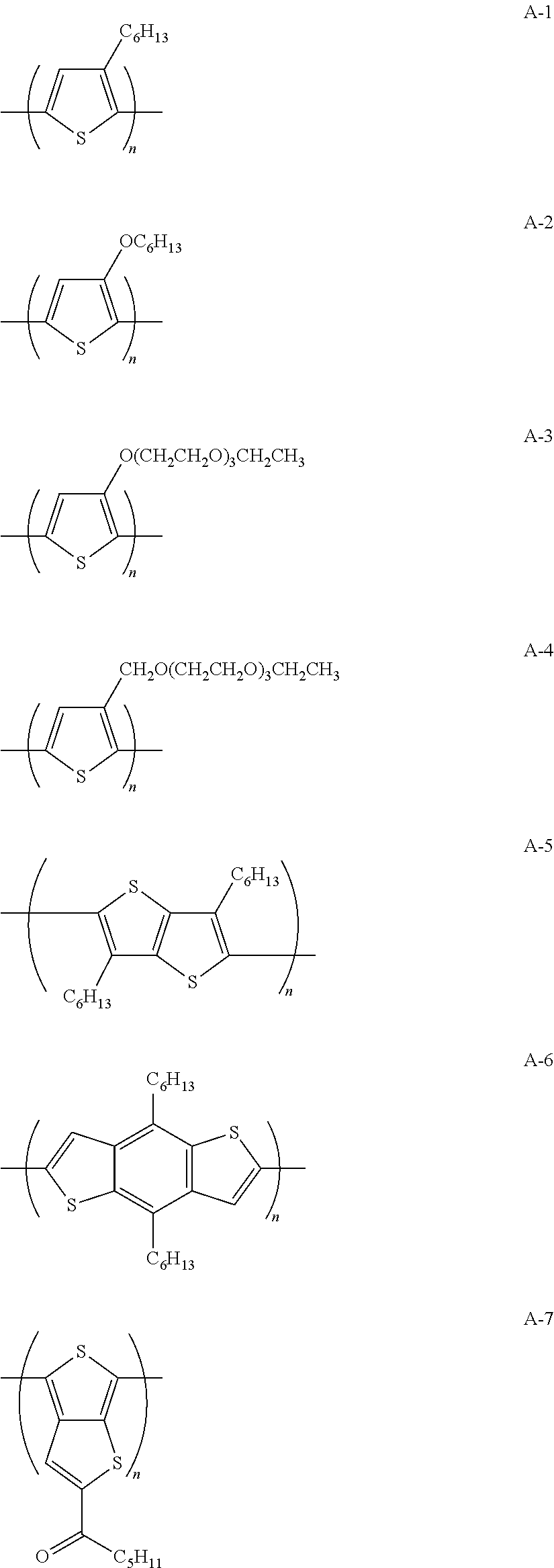Thermoelectric conversion material and a thermoelectric conversion element
- Summary
- Abstract
- Description
- Claims
- Application Information
AI Technical Summary
Benefits of technology
Problems solved by technology
Method used
Image
Examples
example 1
[0178]Then, 10 mg of electrically conductive polymer 1 (weight average molecular weight=87,000, manufactured by Sigma-Aldrich Corporation) shown below, 2 mg of the above-described thermal excitation assist agent 401, and 4 mg of CNT (ASP-100F, manufactured by Hanwha Nanotech Corporation) were added to 5 mL of orthodichlorobenzene, and dispersed thereinto for 70 minutes in an ultrasonic water bath. Then, 4 mg of dopant 107 shown below was added thereto to be sufficiently dissolved, and a mixture was prepared. This mixture was coated on a glass substrate, and a solvent was distilled off by heating the resultant coated product at 120° C. for 15 minutes, and then the resultant material was dried at room temperature for 10 hours under vacuum conditions, and a 2.5 μm-thick film for thermoelectric conversion was prepared. Then, this film was irradiated with ultraviolet light (an amount of light: 1.06 J / cm2) by a UV curing system (ECS-401GX, manufactured by EYE GRAPHICS Co., Ltd.), and an e...
examples 2 to 29
, Comparative Examples 1 to 9
[0189]Films for thermoelectric conversion in Examples 2 to 29 and Comparative Examples 1 to 9 were produced and evaluated in a manner similar to the operations in Example 1 except that electrically conductive polymers, thermal excitation assist agents, and kinds of dopants and presence or absence of addition thereof were changed as shown in Table 1 or Table 2. The results are shown in Table 1 and Table 2.
TABLE 1Kind ofKind ofElectricallythermal|HOMO of the electrically conductive polymer|-conductiveexcitation|LUMO of the thermal excitation assist agent|Thermoelectric characteristicspolymerassist agent(eV)Additive(ZT relative value)Ex 1Ecp 1Teaa 4011.1CNT, Dopant 107100 (reference value)Ex 2Ecp 1Teaa 4021.6CNT, Dopant 101117Ex 3Ecp 1Teaa 4031.5CNT, Dopant 103104Ex 4Ecp 1Teaa 5010.3CNT, Dopant 102113Ex 5Ecp 1Teaa 5021.2CNT, Dopant 10575Ex 6Ecp 1Teaa 5030.6CNT, Dopant 104128Ex 7Ecp 2Teaa 5041.4CNT, Dopant 107102Ex 8Ecp 2Teaa 4071.6CNT, Dopant 106113Ex 9Ecp ...
example 30
[0191]On a glass substrate having an ITO electrode (thickness: 10 nm) as a first electrode, the mixture prepared in Example 1 was coated, and a solvent was distilled off by heating the resultant coated product at 95° C. for 20 minutes, and then the resultant material was dried at room temperature for 4 hours under vacuum, and thus a 2.9 μm-thick first thermoelectric conversion layer was formed. Then, the layer was irradiated with ultraviolet light (amount of light: 1.06 J / cm2) by a UV curing system (ECS-401GX, manufactured by EYE GRAPHICS Co., Ltd.), and an electrically conductive polymer was doped.
[0192]Subsequently, on the first thermoelectric conversion layer, the mixture prepared in Example 7 was coated in a similar manner, and a solvent was distilled off at 95° C. for 20 minutes, and then the resultant material was dried at room temperature for 4 hours under vacuum, and thus a second thermoelectric conversion layer was formed. Then, the layer was irradiated with ultraviolet lig...
PUM
| Property | Measurement | Unit |
|---|---|---|
| Energy | aaaaa | aaaaa |
| Electrical conductivity | aaaaa | aaaaa |
| Energy level | aaaaa | aaaaa |
Abstract
Description
Claims
Application Information
 Login to View More
Login to View More - R&D
- Intellectual Property
- Life Sciences
- Materials
- Tech Scout
- Unparalleled Data Quality
- Higher Quality Content
- 60% Fewer Hallucinations
Browse by: Latest US Patents, China's latest patents, Technical Efficacy Thesaurus, Application Domain, Technology Topic, Popular Technical Reports.
© 2025 PatSnap. All rights reserved.Legal|Privacy policy|Modern Slavery Act Transparency Statement|Sitemap|About US| Contact US: help@patsnap.com



